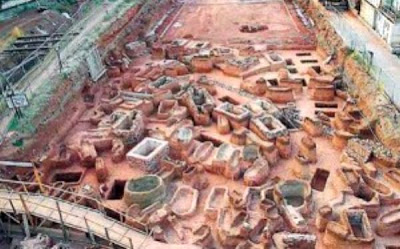Greek Macedonians discovered a valuable treasure hidden in the bowels of the earth, thanks to the methodical excavations undertaken in the construction of the Thessaloniki metro.
Many artifacts found in the archaeology excavation, from items such as gold hoops, benches, and thousands of everyday objects, up to whole churches, remnants of the glorious, long history of Thessaloniki, have come to light. The excavations were completed by the end of the year, leaving behind thousands of “mosaics” of cultures that flourished in the city.
Archaeologists are revealing a palimpsest of the city, a city that has undergone constant and continuous phases of occupation from the 4th century BC, when it was founded in Thessaloniki, until now! “In Byzantium, Thessalonica was described as the second city of Constantinople, precisely because of its extremely important historical position in the region.”
They emphasized, among other things, that the general secretary of the Ministry of Culture, Lina Mendoni, spoke to the Parliamentary Standing Committee on Economic Affairs of the House, ahead of signing an additional contract to perform archaeological work.
“In terms of area stations, there are mainly archaeological investigations in the order of 17,000 sq.m. In essence, speaking of the area of archaeology excavation, we speak about 28,000 square meters, “explained Ms. Mendoni.
Roman Era
Continuing the narration of the general secretary of the Ministry of Culture, he said that the thriving city of Thessaloniki, especially in the Roman period and Byzantine times, as revealed by the excavations of the subway, were much like today’s Egnatia Street, both sides filled with dense structures.
“I remind you that you may know from the novels the Avenue of the Byzantines. It is the old Egnatia, the Roman Egnatia, as revealed, that the marble paved road running through the city exactly where the metro passes. I want to say that especially the Byzantine Thessaloniki, unlike other modern eras for the cities of medieval Europe, has a drainage system that exists in no other medieval city. A large part of the culture of a city is evident in where its trash and waste ends up. This indicates the developed level of Byzantine Thessaloniki with a unique drainage system, which is revealed, “said Mr. Mendoni.
Thousands of Findings
From the subway stations where the excavations are evolving in two key areas, Saint Sophia and Venizelos, located in the historic city center, the excavation has been completed to the level of the Byzantine period, and now begin excavations in deeper layers. They have already discovered about 2,500 square meters of ancient buildings!
Not only the buildings, but also major crops and finds should be preserved. The finds now number over 28,225, and among them are some 5,000 vessels, over 5,000 glass finds, over 1,500 pieces of jewelry, more than 130 signs, and more than 400 figurines. Among those eight golden crowns are wreaths from the excavations in Vergina and Goats.
Postings
Reference was made to posting the monuments. ”There are sites that cannot be lost, to disappear. Therefore, following the provisions of the archaeological law and the public interest, because there are all those documentations required for historical and archaeological research, these monuments will be posted, and a large proportion of these will grace their stations when formulated in Thessaloniki”, said the general secretary of the Ministry of Culture, while referring to the cost required for the maintenance and storage of thousands of finds, which is expected to rise to unfathomable heights.
“Suffice it to say that the Baths of Phoenix, a monument which stood in areas of maintenance, cost about 200,000 euros, and that the rent of some stores is incurred in the cost of archaeological investigations in Kalochori, a very large area, because otherwise they cannot complete the required tasks, while costing about 3,000 euros a month in rent. “
The Money
Earlier, the president of “Metro SA”, Chris Tsitouras, spoke and said the Thessaloniki metro in the past faced many problems, most notably archaeology.
“The basic agreement here is the long-slide provided only 15 million euros for archaeological excavations, when today with an official document from the Ministry of Culture, the final amount is an estimate very close to reality – close to 90 million euros. He had planned to be around 20 months, and the archaeological excavations would finish in late 2009; it is possible to deliver a project and need three years after completion of archaeological excavations, with a planned finish date of around 2012. Imagine the end of 2009, when all excavations should have finished, the year closed with only 11.5% completed, and 19 million euros spent. The slippage of three or four years had just about ended the archaeological excavations, and other issues such as expropriation, technical, etc. To be very precise, archaeology and its problems in the city center, which represents 23 centuries of continuous history – it brought the trend, “said Mr. Tsitouras.
He said that the 15 million forecast in the original contract had already been spent by July 2009. ”So then used money from the contingency of the project is 81 million euros. To date we have spent 48 million for archaeological work. Because of unforeseen work that has delayed the end of the project, in collaboration with the Ministry of Culture, whereas the final cost was estimated at around 90 million – which the managing authority (paying authority) agreed upon – they have now said that there must be a new contract with a new item. For this reason we were led to this additional, supplemental contract,” said Mr. Tsitouras.
Resource from : http://archaeologynewsnetwork.blogspot.in/2012/02/subway-excavations-yield-countless.html
For more interesting topics related to archaeology, visit archaeology excavations.

No comments:
Post a Comment